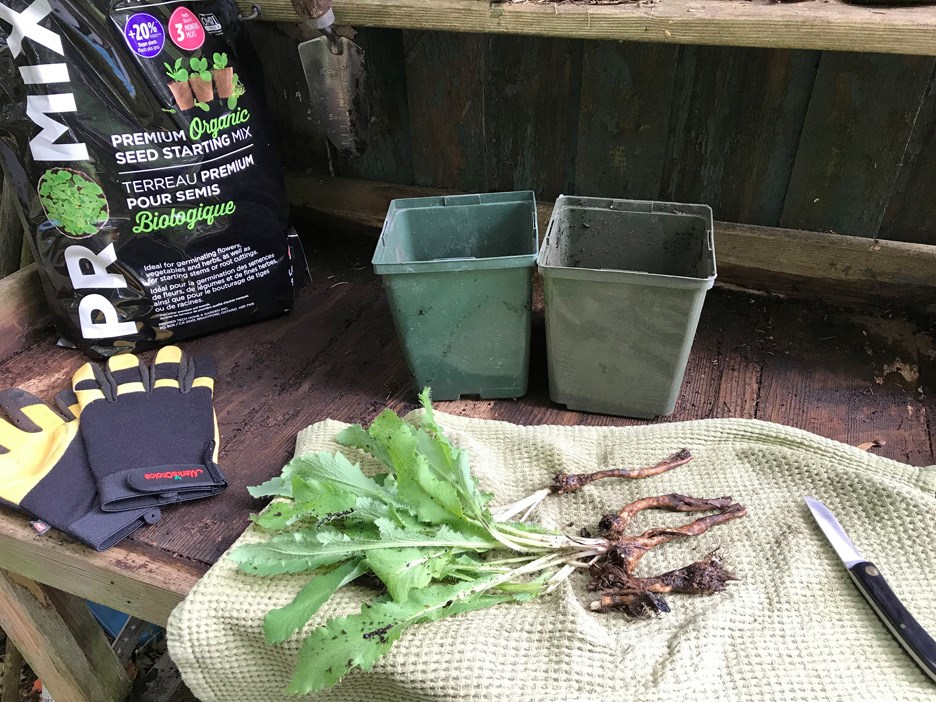You have to love the fact that gardeners share.
In winter, books and knowledge are exchanged, in the spring perennials are divided. By this time of year, vegetables are shared in abundance.
Another great way to maximize the sharing-potential of your garden is by propagating from cuttings, and now is the perfect time of year to do it.
Root Cuttings work best for raspberries, blackberries and ornamentals such as bleeding heart, statice, Oriental poppy, cranesbill (perennial geranium), baby’s breath and yucca.
- Dig up the plantand wash the roots thoroughly with the hose to remove excess dirt. Remove as much of the root mass out of the ground as possible.
- Sterilize a sharp knife or pruners. A solution of 1-part bleach to 9 parts water does the job or simply pass over an open flame, using a lit match or lighter.
- Using the sterilized cutting tool, cut out roots you want to propagate. Look for tan coloured, young and thick roots. Cut them as near as you can to the crown of the parent plant.
- Replant the parent plant immediately. Exposed roots dry out quickly. Replant it and water thoroughly.
- Cut the roots into 5 to 10 cm (2 to 4 inch) pieces straight across, then trim off any fibrous roots and cut the narrowest end on a 45-degree angle.
- Sterilize the cuttings in a 1:20 bleach-water solution. Plant the root angled side down into a tray with a mixture that is half peat moss and half sand or perlite or purchase a “seed and cutting” mix. Bury the cuttings about 6 mm (1/4 inch) deep in the soil mixture.
- Keep the cuttings moist, but not too much to avoid rot. A good place for the cuttings is in a cold frame or unheated room.
- When two or three sets of leaves appear, transplant to individual pots. Keep in a cold frame over winter or on the east or south side of your house, out of the prevailing winds. By spring you will have lots of new plants to share with friends.
Softwood cuttings work well with houseplants and tender perennials such as impatiens, geranium, fuchsia, yarrow, asters, lupine, potentilla and sedums.
- Avoid taking cuttings that are blooming.
- Moisten the potting mix before you take your cuttings.
- Short cuttings root more easily than longer. Take a cutting that is about 10cm (4”) long. Cut just below a node – the bump that a shoot or root will grow from.
- Sterilize your knife or clipper between each cut.
- Remove lower leaves and make an angled cut on the bottom end of the cutting. The top end can be cut straight or left with tip foliage as-is.
- Dip bottom into rooting hormone and insert into the potting mix about 2.5cm (1”) deep, with one node below the soil and with no leaves touching the soil or each other.
- Water well for most cuttings, however bear in mind that succulents and silver-leaved plants such as artemisia and lavender prefer less moisture as they are prone to rotting. Allow the surface of the soil to dry to the touch.
- To keep non-succulents moist, cover the plant with a plastic bagsuspended away from the plant with wire or a wooden popsicle sticks. A plastic hood or an unused aquarium also works well. Expose them to air once a day for an hour to two to prevent fungal disease.
- Remove mildewed or dropped leaves dailyand use a heat mat to accelerate rooting.
- In 7 to 10 days you should have a rooted plant. You will know if the cuttings have developed roots by giving each one a gentle tug. Once they’re rooted, start giving them more ventilation and gradually more sun. Once they’re growing you can begin fertilizing every two weeks with half strength 20-20-20.
It’s a crawl-before-you-walk process which is incredibly rewarding. All the more rewarding when shared.
Mark Cullen is an expert gardener, author, broadcaster, tree advocate and Member of the Order of Canada. His son Ben is a fourth-generation urban gardener and graduate of University of Guelph and Dalhousie University in Halifax. Follow them at markcullen.com, @markcullengardening, and on Facebook.



